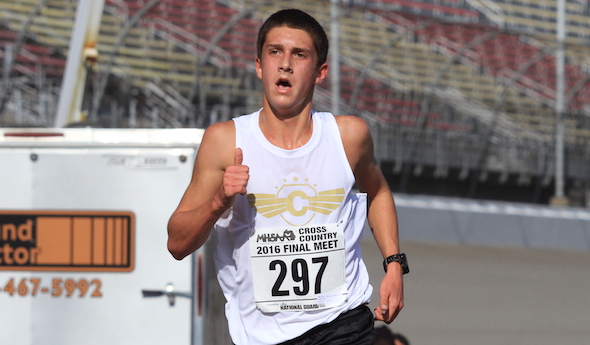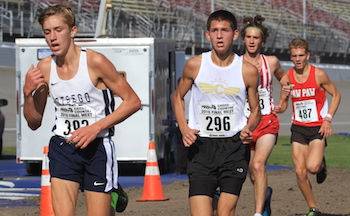
Jacobs, Corunna Finish Title Quests
November 5, 2016
Second Half reports
BROOKLYN – Noah Jacobs’ race was done, but the job wasn’t finished.
So, he took zero time to soak in the moment after he won the MHSAA Division 2 individual cross country championship Saturday at Michigan International Speedway.
Instead, he turned around and kept a close eye on the runners finishing behind him, hoping to see the white Corunna singlets not too far back.
The first teammate he greeted was his sophomore brother, Ben, who finished eighth in 16:01.8.
Before long, he would be reunited with the rest of his teammates. When the places were added up, not only did Jacobs win an individual championship, but he led his school to the team title.
Corunna beat reigning champion Fremont, 92-99, for its first MHSAA championship since 1997.
With his time of 15:28.0, Jacobs joined 1998 winner Jared Aldrich as the only Corunna boys to win the individual title. He won by 12 seconds over Pontiac Notre Dame Prep senior Brendan Fraser.
“I came into the stadium, and the wind was in my face,” said Jacobs, who recently committed to run for the University of Wisconsin. “It was a battle that last mile, it really was. It was one of the harder races I ever ran. The course was a little bit soft; it wasn’t exactly ideal. I’m proud. I gave it everything I had, and my team gave it everything they had. That’s all you can ask for. What I take away from it is it’s a great last race in my Corunna jersey.”
The cross country championship has eluded Jacobs, who has two MHSAA Division 2 track and field titles in the 3,200-meter run on his resume. He was 56th as a freshman, fifth as a sophomore and second to two-time champion Morgan Beadlescomb of Algonac as a junior.
 Jacobs has a personal best of 15:00 in cross country and 8:55.57 in the 3,200, so he had hoped to put his name among the all-time greats who have ever run at MIS. That plan changed when he saw that rain from earlier in the week turned portions of the course into slop.
Jacobs has a personal best of 15:00 in cross country and 8:55.57 in the 3,200, so he had hoped to put his name among the all-time greats who have ever run at MIS. That plan changed when he saw that rain from earlier in the week turned portions of the course into slop.
“Originally, I wanted to run in the 14s,” Jacobs said. “But running the warmup on the course and figuring everything out, it wasn’t worth my time to go out and only think about time. It wasn’t going to be beneficial. It was just going to end in a day I felt I could do more.”
Even with the graduation of Jacobs, Corunna should be well-positioned to repeat next year.
The Cavaliers ran only two seniors Saturday, the other No. 5 man Kyle Mesh. There might even be a future individual champion in the Jacobs household.
Ben Jacobs was fourth among non-seniors and the second sophomore in Division 2. His time was only 5.2 seconds slower than Noah ran as a sophomore at MIS.
“He was one of two guys who PR’d today,” Noah said. “He ran awesome. A lot of people in Michigan don’t know Ben that well. Ben’s a sophomore this year. He has a lot of big things coming. He’s faster in the mile (as a sophomore), but in the 5K he’s a little behind me, but we’re close.”
With junior Dakota Hundley placing 25th in 16:24.5, Corunna had three all-staters. The top 30 make all-state.
Sophomore Charlie Bruckman was 50th in 16:44.2 and Mesh was 52nd in 16:46.4 to round out Corunna’s scoring.
Fremont has won eight MHSAA championships, but was trying to repeat for the first time. Grand Rapids Christian finished third with 139 points.
The MHSAA Cross Country Finals are sponsored by the Michigan National Guard.
PHOTOS: (Top) Corunna’s Noah Jacobs charges toward the finish for his first MHSAA cross country title. (Middle) Ben Jacobs (296), Noah’s brother, finished eighth to help the Cavaliers to their first team title since 1997, while Otsego's Alex Comerford (392) also posted a top-10 finish. (Click to see more from RunMichigan.com.)

MHSAA Vault: MIS Rose to Challenges to Host 2020 LP Finals
By
Rob Kaminski
MHSAA benchmarks editor
November 12, 2021
The “MHSAA Vault” features stories from past publications and other documents in the MHSAA Library. This issue takes a look at the MHSAA Cross Country Finals at Michigan International Speedway, which celebrated 25 years in 2020 – although it was an event that nearly didn’t happen last fall …
In 1996, the MHSAA and Michigan International Speedway began a partnership the changed the course of the Lower Peninsula Cross Country Finals – quite literally.
The land in and around the track at Brooklyn would host the Finals for all classes of runners in one place on one day, an annual festival of nearly 2,000 runners competing for the MHSAA’s top honors.
Even skeptics – and there were several among running purists who thought the course was too flat, for example – can’t deny the results.
Finals attendance nearly doubled in that first year, and crowds in excess of 10,000 have enjoyed a day of racing several times, including a record 12,153 in 2011.
Enthusiastic crowds were the norm in recent years, with 11,232 in 2017, and nearly 11,000 in 2018 (10,989) and 2019 (10,873).
In fact, attendance failed to reach at least 8,000 only twice since the move to MIS.
Of course, last year was an exception, when attendance was limited to 1,000 spectators per session due to the COVID-19 Pandemic. Fans also were restricted to the grandstands rather than following the action throughout locations on the course.
To reduce the number of runners in each race, the event was spread over two days, with each Division being run in two separate “sections” with times then combined at the end to determine team and individual champions.
While not ideal, the end result was another year of fantastic efforts at MIS – both from student-athletes and those behind the scenes.
“Even at the last hour, less than a week ahead of the Finals, we were closer to not having the Finals than we were to having them,” said MHSAA Assistant Director Cody Inglis, who coordinates the cross country postseason. “Rumors and challenges of mandated shutdowns, testing and other requirements were being discussed and caused a lot of unknowns. Even at the Regional level, we had schools, Regional courses and hosts shutting down their facilities; we had to relocate four Regionals 48 hours prior to race times. That scenario just could not happen at the Finals level where far more runners and much more travel would be involved.”
Among the many last-minute hurdles was the edict from NASCAR – which owns MIS – that all persons on site be temperature checked upon entry. That meant securing thermometers that were easy to operate in short order, along with personnel necessary to conduct the readings.
The attendance limitations certainly helped to implement the temperature screening, but brought their own issues.
“Limiting spectators was not a popular decision, but it really was the only way to have a race,” Inglis said. “We were taking direction and working with policies and protocols from the MDHHS, the Governor’s office, Lenawee County Health Department, MIS and NASCAR.”
Part of the solution was to utilize the grandstands as a “barrier” between participants and spectators. The reduced number of fans were dispersed over thousands of seats while still allowing them the chance to watch their student-athletes compete.
“It wasn’t the same, it wasn’t easy or perfect, but it was what we had to do to have a race,” Inglis said. “Separating the Finals into two days and different sections also allowed us to spread out the event and limit the number of people on site at any one time. This was a key part of the plan and worked well even though it separated races within a Division.”
The MHSAA, MIS and the cross country community never lost focus of the main goal: a culmination of the season for the student-athletes, who deserved something last year more than ever. And, more than ever, MIS once again displayed its advantage as a venue that could adapt to the fluid nature of the times to pull off the event.
“There were some thoughts of using four different sites, but as we learned during the Regionals, the climate of things was so tenuous from one area of the state to another that we couldn’t be 100-percent certain that there wouldn’t again be last-minute cancelations,” Inglis said. “MIS was wonderful to work and collaborate with, and was the best option to get it done. It was never mentioned once publicly about the possibility of not having the Finals – only how we could best do it under uncharted conditions.”
The moving parts and ever-changing scenarios created more complexity than ever in finalizing a season, but every decision was made with the complete desire to conduct the Finals as close to normal as possible.
“I firmly believe that a finish to the season, no matter the differences in race formatting and fan experience, was something everyone would have taken when the season began in August,” Inglis said.
Indeed, the finish line in Year 25 at MIS might have been the most gratifying of them all.


